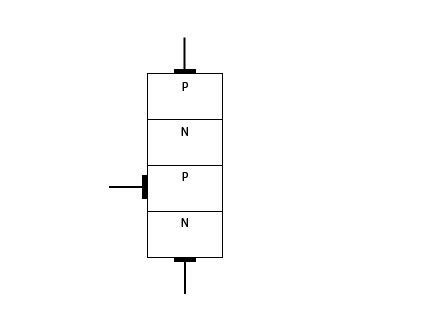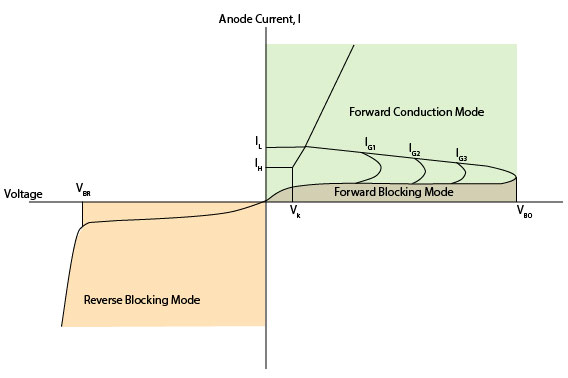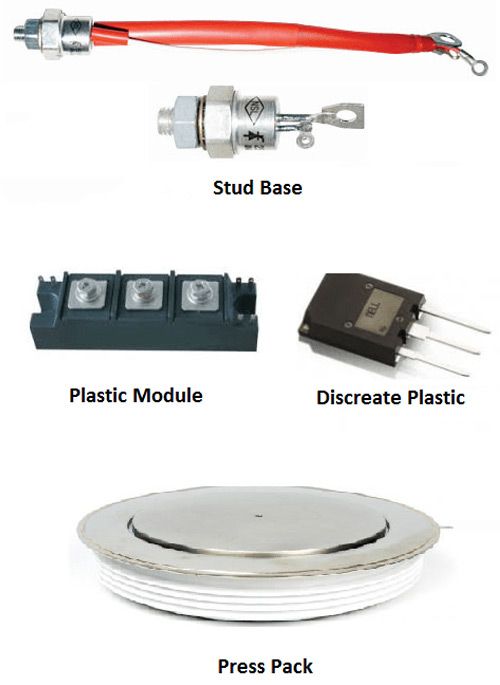What is SCR? The answer is that SCR is a three-terminal and four-layer solid-state device from the thyristor family. This article discusses the SCR symbol, construction, working, applications, packages, and VI Characteristics of SCR.
What does SCR Stand for?
SCR stands for Silicon-controlled rectifier. The SCR is a very important member of the thyristor family. It is more popular than other thyristor family members like TRIAC, and DIAC even though that thyristor is used interchangeably with SCR.
SCR Symbol
The SCR symbol is very similar to the diode symbol, but it has an additional gate terminal. As SCR only allows current in one direction like a diode, the symbol is very similar to the diode symbol. As the anode current is triggered by the gate, therefore the gate terminal is denoted in contrast to the diode symbol.

The three terminals of the SCR are named anode, cathode, and gate. For proper working, connect the anode of the SCR with the positive and the cathode with the negative of the battery. A positive pulse for a short duration is required at the gate to kick-start the conduction.
SCR Construction
SCR has four layers of extrinsic semiconductor materials. These four layers form three PN junctions named J1, J2, and J3. The layers are either NPNP or PNPN. The anode and cathode terminals are placed at the end layers and where the gate terminal is placed with the third layer. The outer layers are heavily doped and the inner two layers are lightly dopped. The SCR Construction is illustrated here below.

- Elevate Your Boating Experience with a Marine SoundBar
- Efficient Travel Refrigerator for Cars: A Complete Guide
SCR Working
SCR working depends upon the battery polarity and the gate input. The SCR can operate in three different modes.
- Forward Blocking Mode
- Forward Conduction Mode
- Reverse Blocking Mode
Forward Blocking Mode of SCR
When the anode of SCR connects to the positive and cathode of SCR with the negative of the battery terminal no pulse is applied at the gate terminal. The SCR works in the forward blocking mode. This means that SCR will not be conducted even though the polarity of SCR is forward bias.
In forward blocking mode, the J1 and J3 PN junctions are forward-biased. But the middle junction J2 is reverse biased, therefore, the SCR will not conduct in the forward blocking mode.
Forward Conduction Mode of SCR
Forward conduction mode is the only mode of SCR for conduction. The SCR can be set into the forward conduction mode in two ways. First by providing the gate pulse to forward bias the J2 junction. Second, increase the anode-to-cathode voltage to break down the J2 junction. The gate pulse method is preferred and suitable for many applications. The breakdown method reduces the SCR lifetime.
The SCR will remain in conduction mode even after the removal of the gate pulse or the reduction of the applied voltage. If the anode current of the SCR drops below the holding current the SCR will stop falling back to forward blocking mode.
Reverse Blocking Mode in SCR
If the anode terminal of the SCR connects to the negative and the cathode terminal of the SCR connects to the positive of battery terminals. The SCR is in reverse blocking mode. In this mode, J1 and J3 junctions are reverse-biased. Where the middle junction J2 is forward bias. As two junctions are reverse biased, so there is no current flowing through it but only a small leakage current due to the drift charge carrier.
VI Characteristics of SCR
The curve of VI characteristics of SCR is obtained by changing the voltage across the SCR and noticing the current through SCR. When connecting in reverse polarity, the SCR will conduct a small current, leakage current up to breakdown voltage, VBR. After that point, the SCR will break down and start to act like a short circuit. Below the breakdown point, the region is called reverse blocking mode.
- Differences Between Fixed Wiring Testing and PAT Testing
- Sustainability in Flex: Green Practices in Flexible PCB Manufacturing
If connected in the forward polarity, the SCR will not allow any current. This region is called forward blocking mode, the region is below the VBO point. The portion of the VI characteristic curve is in the first quadrant. In this region, the current is below the latching current.

When the voltage reaches the VBO point, the SCR starts the current flow. Alternatively, the SCR can be put into the forward conduction mode by applying the gate that will increase the anode current above the latching current. A higher gate current can put SCR faster in the forward conduction mode as in the graph Ig3>Ig2>Ig1. The SCR will remain in the forward conduction mode if the anode current is above the holding current.
SCR Applications
The most common SCR application is the DC motor speed control. The DC motor has two windings, where the armature winding is connected to the AC supply by two SCRs. The SCR controls the amount of current to the motor and ultimately the speed of the DC motor.
SCR Packages
SCR is available in several packages in the market and is used based on the applications. The most common SCR models are BT151, 2P4M, TYN608, and many more. Following are the available packages of SCR.
- Top 5 Essential Electrical Wiring Rules to Follow for Your Home
- Breaker Size Calculator: AC and DC Circuit Breaker Sizing Calculator
Discrete Plastics
The discrete plastic packages are the most common and cheap packaging available up to 1000 volts and 25A current. It is enclosed with a plastic casing that has three pins connecting to it. This package is easily residing on the circuit board along with other components.
Plastic Module
Plastic Module packaging is an array of discreet plastic packages. The plastic module contains multiple SCRs in the array for better circuit organization, heat dissipation, and better visibility. The module can work up to 100A.

Stud Base
The stud base SCR is easily mountable and has a low thermal resistance. It has a screw base that connects to the heat sink. The stud base is available for up to 150 A current and full range voltage.
Flat Base
The flat base SCR is insulated from the heat sink by a small layer of insulation as compared to the stud base SCR. Otherwise, the flat base has similar features to the stud base SCR. A flat base can be available up to 400A current.
Press Pack
The press pack SCR is used for high current and high voltage applications. The press pack is used for current above 200A and voltage above 1200v. The SCR is enclosed in a ceramic envelope for the required isolation. Both terminals, anode, and cathode are attached to the heat sink therefore it offers better heat dissipation properties.
Short Answer Questions:
1. What current needs to trigger SCR?
To fire or trigger SCR, a minimum anode current greater than the latching current is required. The latching current is the property of the SCR and can be found on the datasheet. The latching current can be spotted on VI characteristics of SCR as IL.
2. Is the heat sink of SCR the cathode anode or trigger?
The heat sink is normally connected to the anode terminal of the stud base SCR. To completely identify the terminals, use a multimeter on ohms. The trigger or gate terminal and cathode will show connectivity.
3. How to connect SCRs to get a higher working voltage?
SCRs are connected in series to work at higher voltage and improve the blocking capacity. The voltage distribution between the SCRs relates to the leakage current. Therefore, appropriate adjustments are made for equal voltage distribution.
4. What is the difference between the breakdown and the breakover voltage in SCR?
The breakdown voltage is the voltage limit for reverse blocking mode, and it can be found on VBR on the VI characteristics of SCR. Similarly, the breakover voltage is the limit of the forward blocking mode and it can be found as VBO on the VI characteristics of SCR.
5. How to turn off SCR?
The SCR will turn off automaticity in AC supply due to zero crossing called neutral commutation. Where DC supply, anode current must be reduced below the holding current to turn off the SCR.
6. What are the three modes of SCR?
Three modes of SCR are forward conduction mode where the SCR is ON and SCR is OFF in Forward Blocking mode and Reverse Blocking modes.
Super explanation very neat clean clear and understandable .Thanks for providing a topic in very easy manner
Very good explanation for easy understanding
Interesting post! I’m glad to learn more about SCRs and their characteristics. Can you elaborate more on the construction process and how the different components interact with each other during operation?